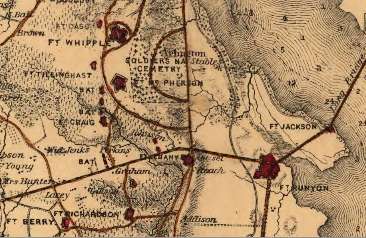Arlington Line

The Arlington Line was a series of fortifications that the Union Army erected in Alexandria County (now Arlingon County), Virginia, to protect the City of Washington during the American Civil War (see Civil War Defenses of Washington and Washington, D.C., in the American Civil War).
Just across the Potomac River from the Union capital city, Confederate Virginia was a major Union concern when the war began. In May 1861, federal troops seized much the County and immediately began constructing a group of forts near Washington on the Virginia side of the River to protect the capital city.
After the Confederacy routed the Union Army at the First Battle of Bull Run (Manassas) in late July 1861, the Army quickly began construction on a line of breastworks and lunettes to the west of the earlier fortifications. These and larger fortifications later constructed nearby became known as the Arlington Line. This included a lunette Fort Cass and Fort Whipple which became current day Fort Myer later to be renamed as Joint Base Myer Henderson Hall
The Arlington Line was never attacked, even after the federal defeat at the Second Battle of Bull Run (Manassas) in late August 1863. The Line therefore effectively served its strategic purpose.
Major Daniel Phineas Woodbury was the Union engineer who designed and constructed the Arlington Line. One of its forts, Fort Woodbury (which once stood in what is today Arlington's Courthouse neighborhood), was named for him.
References/External links
- Arlington Historical Society - Arlington Line
- Arlington Historical Society - Military-use structures
- Cooling III, Benjamin Franklin; Owen II, Walton H. (2010). The Arlington Lines. Mr. Lincoln's Forts: A Guide to the Civil War Defenses of Washington (New ed.). Scarecrow Press. p. 82. ISBN 978-0-8108-6307-1. LCCN 2009018392. OCLC 665840182. Retrieved 2018-03-05 – via Google Books.
Coordinates: 38°53′22.5″N 77°5′1.5″W / 38.889583°N 77.083750°W